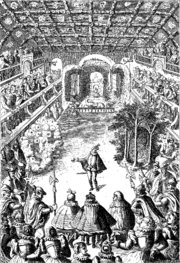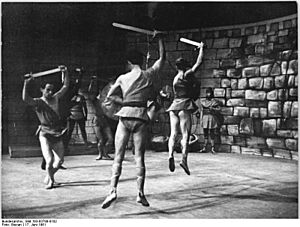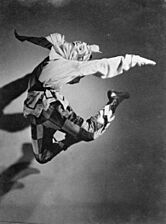History of ballet facts for kids

Ballet is a beautiful dance style that started in the royal courts of Italy in the 1400s and 1500s. It then moved to France with the help of Catherine de' Medici, an Italian noblewoman who loved the arts. She helped ballet grow even more. Early ballets were often grand shows for royal weddings and important visitors. Rich nobles paid for these early "court ballets." They used dance, music, and stories to entertain and even show off their power.
In the late 1600s, Louis XIV of France, who loved to dance, started the first professional ballet company, the Paris Opera Ballet. This is why many ballet words are in French! Ballet soon became its own art form, though it was still often linked to opera. It spread from Europe to other countries. The Royal Danish Ballet and the Imperial Ballet in Russia started in the 1740s and became very famous. Later, in 1907, Russian ballet, especially Sergei Diaghilev's Ballets Russes, became very important in France. Soon, ballet companies started all over the world, like The Royal Ballet in London (1931) and the New York City Ballet (1948). In the 1900s, ballet styles kept changing. For example, George Balanchine created neoclassical ballet in the United States. The word "ballet" comes from the French word ballet, which came from the Italian word balletto, meaning "little dance." This word comes from ballare, which means "to dance."
Contents
How Ballet Began
Early Days in Italy and France
Ballet started in Italy as part of big celebrations in royal courts. These were often for noble weddings. Back then, dancers didn't wear tutus or pointe shoes. They wore regular fancy clothes of the time. Early ballets were interactive, meaning the audience would sometimes join in the dancing at the end.
One of the first dance teachers was Domenico da Piacenza around the 1400s. He taught nobles how to dance. In 1489, a big dance show was put on for a wedding in Italy. It told a story about Jason and the Argonauts. This show was so amazing that many similar ones were created.
Ballet grew even more in France with the ballet de cour, or "court ballet." These were social dances performed by nobles, mixed with music, speeches, songs, and costumes. When Catherine de' Medici married the French king Henry II, she brought her love for dance to France. She gave money to support these grand shows, which often had stories about mythology. The first ballet de cour was the Ballet de Polonais in 1573. It was choreographed by Balthasar de Beaujoyeulx and had 16 women dancing for an hour. Another famous one was Ballet Comique de la Reine in 1581. It lasted over five hours and had 24 dancers.
17th Century: French Court Dance
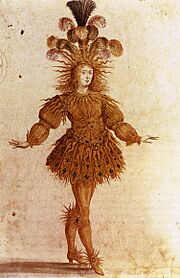
Ballet became a serious performance art in France during the time of Louis XIV. He loved dance and used it to show his power. He made dancing a very important part of court life. This helped make classical ballet more refined with new rules.
In 1661, Louis XIV started the Académie Royale de Danse (Royal Dance Academy). He wanted to improve dance standards and keep nobles focused on court life rather than military matters.
Louis XIV also asked Pierre Beauchamp, his dance teacher, to create a way to write down dances. Beauchamp came up with a system that included the five basic foot positions still used in ballet today. Another dance master, Raoul Auger Feuillet, later published this system in 1700, and it became very popular in Europe.
At this time, a dance style called "La belle danse" (the beautiful dance) was popular in courts. It was very demanding and showed off a dancer's noble status. Men were usually the main performers in these dances, showing off their strength and grace. Women performed in other ballets but not usually in these very formal ones until later.
Jean-Baptiste Lully, a talented musician and dancer, joined Louis XIV's court in 1652. He helped shape ballet for the next 100 years. Louis XIV often danced in Lully's ballets. The king even got his nickname, "Sun King," from his role as the Sun God in Lully's Ballet de la Nuit (1653). This ballet was huge, lasting 12 hours! Lully's music was special because he wrote it to fit the dancers' movements perfectly. He also worked with the playwright Molière to create comédie-ballet, which mixed comedy with dance.
In 1669, Louis XIV started the Académie d'Opéra. After he stopped dancing in 1670 (because he gained weight), Lully became the director of the new Académie royale de Musique. Lully created a new type of opera called tragédie en musique, which included short ballet scenes. His work combined music, drama, and dance, setting the stage for ballet's future.
Ballet Spreads Across Europe
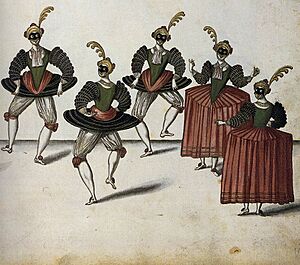
France's royal court was a trendsetter for other European courts. Other countries copied their entertainment styles, including royal ballets. Courts in Spain, Portugal, Poland, and Germany all started to enjoy and take part in ballets. Italy, especially Venice, also became very important for ballet.
Professional ballet groups started forming and traveling around Europe, performing for noble audiences. In Poland, King Władysław IV Vasa (1633–1648) had Italian operas that included ballet dancers. Famous ballet masters worked for the Polish court.
18th Century: Ballet Becomes an Art Form
The 1700s were a time when ballet became more advanced and a serious art form, like opera. A key figure was Jean-Georges Noverre. In his book Lettres sur la danse et les ballets (1760), he said that ballet should tell a story through the dancers' movements. Noverre believed that ballet should make the audience feel emotions, have clear plots, and that the scenery and music should match the story. He also thought that pantomime (acting without words) should be simple to understand.
Ballet was divided into three main styles: sérieux (serious), demi-caractère (half-character), and comique (comic). Ballet also started to appear as short dance breaks, called divertissements, in operas.
Venice remained a dance hub, especially during the Venice Carnival. Dancers and visitors from all over Europe came to the city. Ballet also spread to Eastern Europe, with professional companies performing in Hungary and abroad.
19th Century: Romantic Ballet and Russia
In the early 1800s, the ballerina became the most popular dancer, taking the focus away from male dancers. Sometimes, women even played the male heroes in ballets.
Ballet companies became more professional. Vienna was a key place for ballet teachers. The 19th century saw big social changes, and ballet reflected this with the rise of romantic ballet. Ballerinas like Marie Taglioni and Fanny Elssler tried new techniques, like pointework (dancing on the tips of their toes), which made the ballerina the star. Taglioni was known for her light and pure style. Elssler was famous for her fiery dancing. Teachers like Carlo Blasis wrote down ballet techniques that are still used today. The boxed toe shoe was invented to help with pointe work.
Romantic Movement in Ballet
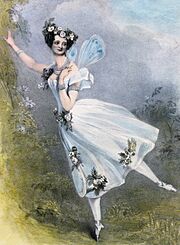
The Romantic movement in art was about freedom and emotion, a contrast to the strict rules of the time. Romantic ballets looked light and airy. They often showed women as delicate, almost magical beings who seemed to float. Ballerinas wore flowing, pastel skirts that showed their legs. The stories were often about magical spirits from folklore. La Sylphide is an example of a romantic ballet still performed today.
This period also saw an interest in folklore and different cultures. This led to ballets showing European folk dances and sometimes characters from African, Asian, and Middle Eastern cultures. However, these characters were often shown in a way that fit Western ideas, sometimes as villains or silly characters. Many major European ballet companies that exist today were started in the mid-to-late 1800s, like the Kyiv Ballet and the Hungarian National Ballet. These theaters often had opera, drama, and ballet companies all in one place, allowing for collaboration.
Ballet in Russia

While France was important for early ballet, Russia became a huge influence. After 1850, ballet became less popular in Paris but thrived in Denmark and Russia, thanks to masters like Marius Petipa. In the late 1800s, there was a trend called orientalism, where people were fascinated by Asian and African cultures, though often with misunderstandings. Petipa created ballets like The Pharaoh's Daughter (1862) and La Bayadère (1877) that fit this trend.
Petipa is best known for working with the composer Tchaikovsky. He choreographed famous ballets like The Nutcracker (1892), The Sleeping Beauty (1890), and the classic version of Swan Lake (1895). These stories came from European folklore. The short, stiff tutu that we recognize today started to appear at this time.
Ballet in Argentina
In the mid-1800s, European ballet companies began touring in North, Central, and South America. The famous Colon Theater in Buenos Aires, Argentina, hosted European ballet artists as early as 1867. By the 1880s, the Colon Theater had its own professional ballet company.
20th Century and Modern Ballet
Russia and the Ballets Russes
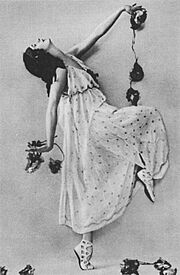
Sergei Diaghilev brought ballet back to Paris with his company, Ballets Russes. It was made up of Russian dancers who had left Russia after the Revolution. Diaghilev and composer Igor Stravinsky created ballets based on Russian folklore, like The Firebird and Petrushka.
Michel Fokine, another important choreographer, also worked with the Ballets Russes. He believed ballet needed more than just pretty moves; it needed drama, expression, and historical accuracy. He choreographed famous works like The Dying Swan, performed by the legendary Anna Pavlova.
Under Soviet rule, Russian ballet continued to develop. Agrippina Vaganova taught dancers with great technical skill and precision at the Vaganova Ballet Academy. Ballet was very popular with the public. The Bolshoi and Kirov ballet companies were very active. Some ballets from this time, like Romeo and Juliet by Prokofiev, were masterpieces. Cinderella, also with music by Prokofiev, was another product of Soviet ballet. After the Soviet Union ended, these ballets became more known outside of Russia. Russian companies touring the world after World War II helped bring new life to ballet in the West.
Maiden Tower (1940) by Afrasiyab Badalbeyli is known as the first ballet in the Muslim East.
Ballet in the United States
After the Ballets Russes moved to France, ballet started to have a bigger impact, especially in the United States. Michel Fokine moved to New York. He believed that ballet needed drama and expression, not just fancy steps. He wanted choreographers to research the time period and culture of the story and use accurate costumes instead of traditional tutus.
George Balanchine created a new style of ballet in America. He opened a school in New York and brought ballet to movies and television. He choreographed new ballets and also created his own versions of classics like Swan Lake. In 1967, Balanchine's Jewels was special because it focused on a theme rather than a story. This style fit with how art was supported in the U.S., encouraging freedom of thought. Today, thanks to Balanchine, ballet is very well-preserved around the world.
Barbara Karinska, a skilled seamstress, worked with Balanchine to make costumes an important part of ballet. She designed tutus that gave dancers more freedom to move.
Ballet During the Cold War
The Cold War was a time of competition between the United States and the Soviet Union. Ballet performances became a way to show off each country's artistic freedom and culture. Companies like the Bolshoi Ballet from the Soviet Union and the American Ballet Theatre from the U.S. traveled internationally. These tours were not just about dance; they were also a way for governments to show their influence. Even with their differences, ballet in both countries had more in common than people thought. Famous dancers like Rudolf Nureyev and Mikhail Baryshnikov left the Soviet Union for the West during this time, drawing attention to artistic freedom.
Sometimes, cultural differences caused problems. When the Bolshoi Ballet performed "Spartacus" in the U.S., Americans were confused. A Hollywood movie with the same name had just come out, and audiences expected something different. The dancers wore Roman sandals instead of pointe shoes, which was unusual for a ballet. This led to negative reactions, and the ballet was removed from some shows.
Despite this, ballet was used as a tool of soft power, helping countries share their culture. The Ballets Russes, a company in Paris with Russian dancers, helped Americans see Russia positively. They brought Russian music, costumes, and stories to their shows. Ballets like Petrushka were very popular. These performances helped create a view of Russia as a place of great artistic talent. After the Ballets Russes, Russian ballet was accepted in American culture and inspired America to develop its own ballet.
In 1963, Lincoln Kirstein's American Ballet became very successful. It helped establish George Balanchine's neoclassical style as a major part of American culture. The Cold War changed how art was funded and organized, showing how much people believed in art's power to influence society. Ballet performances sometimes had political messages, starting discussions about society and art's role. Overall, ballet during the Cold War helped American culture by bringing new styles and techniques, growing dance education, and making ballet more popular in the U.S.
Neoclassical Ballet
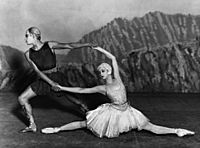
George Balanchine is often seen as the creator of neoclassical ballet. This style is a mix between classical ballet and modern contemporary ballet. His ballet Apollo (1928) is thought to be the first neoclassical ballet. It was a return to a more structured style after some very abstract ballets. Apollo and other works by Balanchine are still performed today, especially by the New York City Ballet.
Frederick Ashton is another important choreographer known for the neoclassical style. Three of his ballets are very famous: Sylvia (1952), Romeo and Juliet (1956), and Ondine (1958).
Contemporary Ballet
Mikhail Baryshnikov, a dancer who trained with Balanchine, became the artistic director of American Ballet Theatre in 1980. He worked with modern choreographers like Twyla Tharp. Tharp created Push Comes To Shove (1976) and In The Upper Room (1986). These pieces were new because they mixed modern dance moves with pointe shoes and classical ballet training, creating contemporary ballet.
Tharp also worked with the Joffrey Ballet company, choreographing Deuce Coupe (1973) using pop music and a mix of modern and ballet techniques. The Joffrey Ballet continued to perform many contemporary pieces.
Today, there are many contemporary ballet companies and choreographers. Even traditional classical companies like the Kirov Ballet and the Paris Opera Ballet regularly perform contemporary works.
Ballet Training Methods
Several well-known ballet training methods are named after the people who created them. For example, two popular systems from Russia are the Vaganova method, named after Agrippina Vaganova, and the Legat Method, after Nikolai Legat. The Cecchetti method was created by Italian dancer Enrico Cecchetti. The Bournonville method, created by August Bournonville, is mainly used in his home country of Denmark.
|
See also
 In Spanish: Historia del ballet para niños
In Spanish: Historia del ballet para niños
- List of ballets by title
- Ballet music
- History of dance
- Black women in ballet


